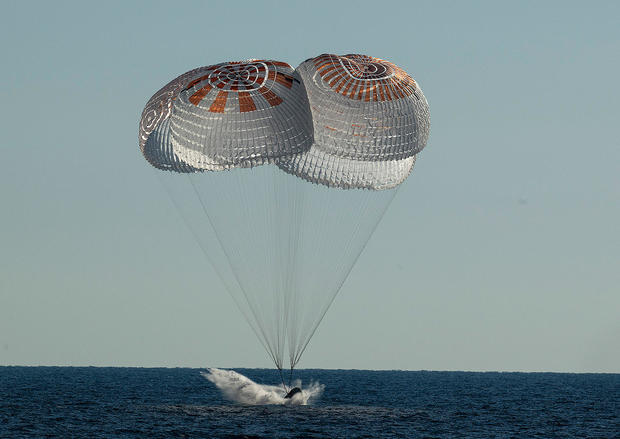SpaceX Crew Dragon astronauts wrap up 170-day space station visit
Three NASA astronauts and a European flier boarded their SpaceX Crew Dragon capsule, undocked from the International Space Station and plunged back to Earth Friday, splashing down in the Atlantic Ocean east of Jacksonville to close out a 170-day mission.
With Crew 4 commander Kjell Lindgren and co-pilot Bob Hines monitoring cockpit displays — flanked by Jessica Watkins and European Space Agency astronaut Samantha Cristoforetti — the Crew Dragon "Freedom" undocked from the Harmony module's upper port at 12:05 p.m. EDT, and slowly backed away.
"We're sad to see you go, we wish you godspeed, safe re-entry and landing and calm seas," radioed Frank Rubio from inside the station. "We're going to miss you guys ... Enjoy your time with your families."
"It was an absolute pleasure and privilege to serve on the space station for the past six months," Lindgren replied. "It was a joy to get to work with you ... We know that you're going to continue to do amazing things on station. We look forward to seeing you back home as well."
After moving a safe distance away, Lindgren and his crewmates monitored an automated 16-minute deorbit rocket firing, starting at 4:01 p.m., that slowed the capsule's 4.7-mile-per-second orbital velocity by about 260 mph.
That was just enough to drop the spacecraft out of orbit for re-entry along a northwest-to-southeast trajectory across the heartland of America.
Descending under four large parachutes, the capsule gently splashed down off Florida's east coast at 4:55 p.m., within sight of a SpaceX recovery ship stationed nearby.
"On behalf of SpaceX, welcome home," a flight controller radioed from the company's control center in Hawthorne, California. "Thanks for flying SpaceX."
"And SpaceX, from Freedom, thank you for an incredible ride up to orbit and an incredible ride home," Lindgren replied. "It's a pleasure to be back."
Support personnel aboard the recovery ship then hoisted the capsule out of the water, opened the hatch and helped the astronauts make their way out as they began re-adapting to gravity after nearly six months in weightlessness. Mission duration: 170 days and 13 hours since launch on April 27.
All four looked healthy and in good spirits, smiling and waving to recovery crews as they were helped out one at a time, put on reclining stretchers, and taken inside the ship for medical checks. On hand to welcome them home was Megan McArthur, an astronaut who flew on the third piloted Crew Dragon mission, and who the recovery ship was named after.
Following initial medical checks, NASA planned to fly all four back to the Johnson Space Center in Houston. Cristoforetti will be flown from there back to Europe aboard a European Space Agency jet.
During a news conference before departing the space station, all four crew members said their first priority was getting home to their families, along with hot coffee in a cup, pizza and ice cream.
"I'd say besides family and friends and a good shower, I certainly look forward to the opportunity of spending time in nature and just enjoying all the sensations that a natural environment provides," said Cristoforetti, the outgoing station commander.
Added Lindgren: "Probably a cold drink with ice in it. Drinking from a glass or a mug and some great coffee. Ice cream sounds really (good) ... But definitely looking forward to getting back home, getting back to our families and just relaxing with everybody there."
As for what they'll miss about life in space: weightlessness and the view of Earth from 260 miles up.
"All of us are going to miss being able to float," Lindgren said. "It's a such a bizarre thing and so amazing that our brains are able to adjust to it so quickly. ... It's an amazing way to be able to get around.
"I think we'll miss floating and miss just the views, you know, the opportunity when you're floating past a window, to just look out and see Australia or Africa, or the immensity of the ocean with clouds speckled across it. It just freezes you, and you just want to you stare at it for a little while and just try to comprehend it. We're all gonna miss that."
Undocking marked the conclusion of a complex sequence of flights to replace the space station's entire seven-member crew.
On Sept. 21, a Russian Soyuz spacecraft carried two cosmonauts and a NASA astronaut to the station — Sergey Prokopyev, Dmitri Petelin and Rubio — replacing three other cosmonauts who returned to Earth on September 29 after a half-year stay.
A SpaceX Crew Dragon then took off on Oct. 5, carrying NASA astronauts Nicole Mann and Josh Cassada, along with Japanese veteran Koichi Wakata and cosmonaut Anna Kikina, the first Russian to launch aboard a U.S. rocket in nearly 20 years.
Kikina's addition to the crew, and Rubio's seat aboard the Soyuz, were part of a new agreement between NASA and the Russian space agency Roscosmos to resume launching U.S. astronauts aboard Russian ferry ships, and to start launching cosmonauts aboard Crew Dragons.
The goal is to make sure at least one representative of each country is always on board the station to operate their respective systems in case a medical emergency or some other issue forces a Soyuz or Crew Dragon to depart early, taking its crew back to Earth ahead of schedule.
With Crew 5 aboard the station, and Crew 4 now back on Earth, NASA will turn its collective attention to readying the $4.1 billion Artemis 1 Space Launch System moon rocket for its return to the launch pad in early November.
After coping with a variety of hydrogen leaks and two launch scrubs in August and September, NASA plans to make another attempt to get the huge rocket off the ground for its delayed maiden flight on Nov. 14, kicking off a 25-day mission to send an unpiloted Orion capsule around the moon and back.




